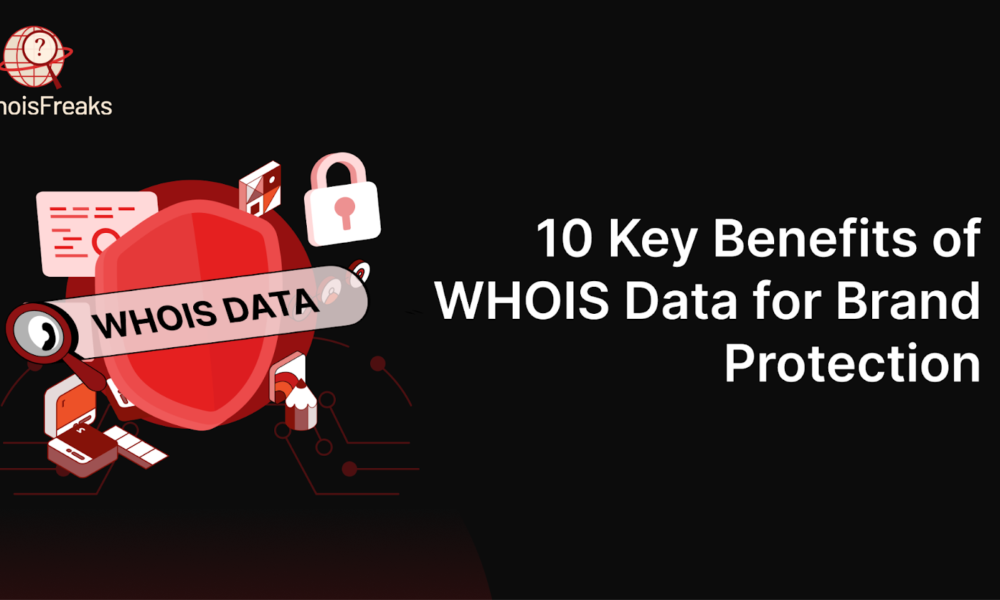10 Key Benefits of WHOIS Data for Brand Protection

The internet is both an opportunity and a risk for brands today. While it offers a global platform to showcase your products and services, it also exposes your brand to countless threats, such as impersonation, domain squatting, and cyberattacks. But there’s hope: WHOIS data has become an indispensable asset for safeguarding brands and ensuring a secure digital ecosystem.
In this article, we’ll explore the importance of WHOIS data for brand protection and delve into how it strengthens cybersecurity efforts. Whether you’re a business owner or a cybersecurity professional, this guide will help you harness WHOIS insights to protect your brand and its reputation.
What is WHOIS Data and Why Does it Matter?
WHOIS data is a database that contains critical registration details about domain names. It stores information such as the domain registrant’s name, contact details, registration date, and expiration. By accessing WHOIS records, businesses and security professionals can trace the origins of websites, identify fraudulent domains, and uncover connections between suspicious entities.
In an age where digital crime is on the rise, WHOIS data acts as a powerful tool for proactive brand protection and risk mitigation. It enables businesses to stay one step ahead of cybercriminals, monitor threats, and maintain consumer trust.
The Role of WHOIS Data in Brand Protection
1. Identifying Domain Squatters
One of the biggest threats to brands is domain squatting or cybersquatting. Cybercriminals register domain names similar to your brand name with the intent to sell them back at exorbitant prices or impersonate your brand. WHOIS data enables you to identify these squatters, trace their contact details, and take swift legal action.
2. Detecting Impersonation Websites
Fake websites that mimic legitimate brands are often used in phishing scams. WHOIS data can help pinpoint the registrants of these impersonation websites, allowing businesses to take down such domains before significant harm is done.
3. Enabling Proactive Brand Monitoring
By integrating a brand monitoring tool, such as WHOISFreaks’ Brand Monitoring, businesses can monitor domain registrations that are similar to their trademarks. This early detection enables them to prevent unauthorized use of their brand identity.
4. Strengthening Trademark Enforcement
Trademark infringement is a growing concern in today’s digital landscape. WHOIS data gives businesses the evidence they need to protect their trademarks and file infringement claims. By identifying the registrants behind infringing domains, brands can enforce their legal rights effectively.
5. Preventing Domain Hijacking
Domain hijacking occurs when cybercriminals gain unauthorized control over a brand’s domain. With WHOIS data, businesses can verify ownership, ensure contact details are accurate, and identify vulnerabilities that may lead to hijacking.

How WHOIS Data Enhances Cybersecurity
6. Investigating Malicious Domains
WHOIS data provides critical insights into domains associated with malware, phishing, or other cyberattacks. Cybersecurity teams can use this information to trace the origins of malicious websites and identify potential attackers.
7. Tracking Cybercriminal Networks
Cybercriminals often use multiple domains in their campaigns. By analyzing WHOIS data, investigators can uncover links between different domains and trace them back to a common source, disrupting entire criminal networks.
8. Reducing Phishing Risks
Phishing attacks rely on fake domains to trick victims. WHOIS data helps cybersecurity teams quickly identify and block these domains before they can launch attacks, reducing the risks to both brands and their customers.
9. Strengthening Incident Response
In the event of a cybersecurity breach, WHOIS data can play a critical role in incident response. It provides essential details about domains involved in the attack, enabling rapid containment and mitigation.
10. Enhancing Threat Intelligence
WHOIS data is a valuable addition to any threat intelligence framework. By analyzing domain registration patterns, organizations can identify emerging threats and proactively defend against them.
Why Brand Protection is More Important Than Ever
The digital age has made it easier for brands to connect with consumers, but it has also made them more vulnerable to fraud and impersonation. Cybercriminals are constantly evolving their tactics, and without robust brand protection measures, businesses risk losing customer trust, revenue, and even their reputation.
By leveraging WHOIS data and tools like a brand monitoring tool, brands can stay ahead of the curve. They can monitor potential threats, enforce trademarks, and ensure their digital presence remains secure.
Best Practices for Using WHOIS Data for Brand Protection
Ensure Accurate Domain Records
Maintaining up-to-date WHOIS records for your domains is essential. Accurate records not only enhance your credibility but also protect your domain ownership.
Monitor Similar Domain Registrations
Use a brand monitoring tool to track new domain registrations that may mimic your brand. Early detection is key to preventing misuse.
Collaborate with Cybersecurity Teams
WHOIS data should be part of a broader cybersecurity strategy. By sharing WHOIS insights with your security team, you can strengthen defenses and mitigate risks more effectively.
Take Legal Action When Necessary
If WHOIS data uncovers trademark infringement or malicious activity, don’t hesitate to pursue legal action. It’s a vital step in protecting your brand.
Real-Life Examples of WHOIS Data in Action
Case Study: Stopping a Phishing Campaign
A leading e-commerce brand detected multiple phishing domains impersonating their website. By analyzing WHOIS data, they identified a pattern among the domains, traced them back to a single registrant, and took legal action to shut down the operation.
Case Study: Preventing Cybersquatting
A tech company used a brand monitoring tool to identify a cybersquatter who had registered domains similar to their new product name. With the help of WHOIS data, they swiftly negotiated the transfer of those domains before launch, saving millions in potential losses.
FAQs
What is WHOIS data, and how is it accessed?
WHOIS data is a public record of domain registration details, accessible through WHOIS lookup tools. These tools provide information like domain owner names, contact details, and registration dates.
How does WHOIS data help in brand protection?
WHOIS data helps brands identify fraudulent domains, detect impersonators, and monitor similar domain registrations to prevent misuse of their trademarks and reputation.
Can WHOIS data be used to track cybercriminals?
Yes, WHOIS data can be used to trace the origins of malicious domains and uncover links between cybercriminal networks, making it a valuable tool in cybersecurity investigations.
Is WHOIS data always accurate?
The accuracy of WHOIS data depends on the registrant’s input. However, many domain registrars enforce policies to ensure accurate and up-to-date information.
What is a brand monitoring tool, and how does it work?
A brand monitoring tool tracks domain registrations that are similar to your brand name or trademarks. Tools like WHOISFreaks’ Brand Monitoring alert businesses to potential threats and help them take timely action.
Can WHOIS data prevent domain hijacking?
Yes, WHOIS data helps businesses verify domain ownership and identify vulnerabilities, reducing the risk of domain hijacking.
Final thoughts
In an era where online threats are escalating, leveraging WHOIS data has become a critical strategy for both brand protection and cybersecurity. By integrating WHOIS insights into your security protocols and using advanced tools like a brand monitoring tool, you can safeguard your brand’s reputation, protect customer trust, and stay resilient against cyber risks.
The digital world isn’t without challenges, but with the right tools and strategies, your brand can thrive securely.





